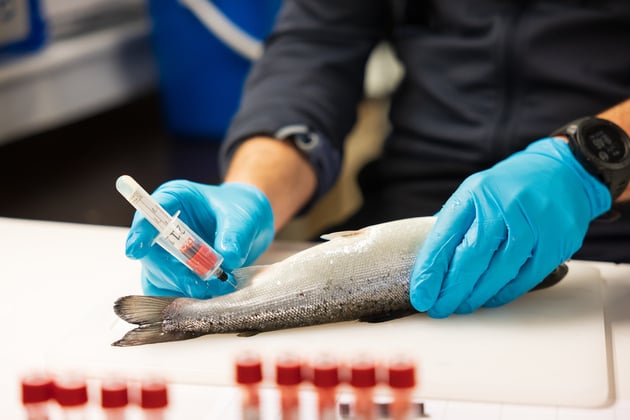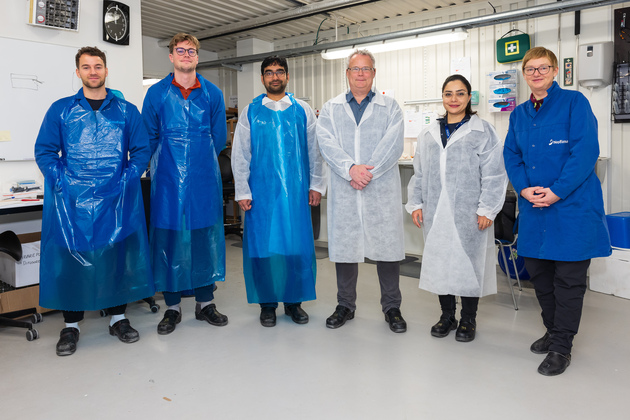Time of year for sea transfer decides RAS strategy

Raising large salmon smolt in Recirculating Aquaculture Systems (RAS) is pioneering work. Therefore, fish farmers have requested research on how different production strategies for large smolt in RAS affect growth, survival rates, welfare and sexual maturity during the sea phase.
Scientists Trine Ytrestøyl from Nofima and Tom Ole Nilsen from the University of Bergen are trying to find answers.
Testing the effect of RAS conditions on growth at sea
In their trials, which are still ongoing, the salmon were raised in land-based RAS according to various production strategies at Nofima in Sunndalsøra. The strategies involved different photoperiods and the use of brackish water while the salmon are in tanks with recirculating water, and smolt size when transferred to sea.
See sidebar to te right for set up of the trials.
Is continuous light in RAS facilities safe?
Salmon that are exposed to continuous light in RAS grew fastest while in the RAS facility and were therefore larger when transferred to sea compared to fish that received a winter signal. No obvious negative effects of using continuous light in RAS were seen on growth in tanks with seawater, and they had the highest weight gain during 12 weeks in seawater.
Brackish water is also a method of gradually acclimatising salmon to seawater. The growth of salmon transferred to sea at 100 grams was not affected by whether it had been raised in RAS facilities with brackish water, while brackish water had a positive effect on growth for fish that were transferred to sea when they were 300 grams.
The main finding so far from the trial in tanks with seawater is that the fish also grow well at sea when exposed to continuous light in RAS facilities. The scientists see that an early winter signal in RAS facilities is very positive for growth at sea when the fish are transferred in sea conditions corresponding to the autumn season, i.e. high temperature and decreasing daylight hours, and that brackish water had a reinforcing effect when the fish were transferred at 300 grams.
“The conditions that fish farmers should give the salmon in RAS facilities seem to depend on which time of year the fish are to be transferred to sea”, says Ytrestøyl.
Large smolt risk becoming sexually mature too early
Early sexual maturation in male salmon is a common problem when the fish are exposed to high temperatures in RAS facilities. Very few of the fish that were transferred to sea at 100 grams became sexually mature early.
When salmon were transferred to tanks with seawater at 300 grams a larger proportion of the males were sexually mature when the sea trial ended.
Scientist Tom Ole Nilsen is not surprised that large smolt have certain challenges that traditionally smaller smolt do not have.
“When you work in unison with the salmon’s physiology, it is natural to assume that the risk of adverse episodes during the seawater phase is lower. We see somewhat earlier sexual maturity and also more incidents of the disease nephrocalcinosis in fish raised in RAS facilities until they are as large as 300 and 800 grams, compared to 100 grams. Therefore, it is important that we take biology into account when choosing a strategy”, says Nilsen.
So far in the trial, the lowest mortality rates have been seen in net-pens at sea where the transferred salmon were 100 grams.

Scientists and students from University of Bergen and Nofima teamed up to analyse fish in RAS. Tom Ole Nilsen in white coat and Trine Ytrestøyl in blue. Photo: Terje Aamodt / Nofima
Is there anything one should avoid doing?
“Based on the results from this trial, I would not give a late winter signal, i.e. at 120 grams, to a fish that is to be transferred when it is 300 grams. It seems to have a negative effect regardless of the season and temperature when transferring to sea, but it will be exciting to see how the fish cope in net-pens at sea up until slaughter size”, says Ytrestøyl.
The research conducted in CtrlAQUA confirms what we have heard before, that all roads lead to Rome.
“Fish farmers that are interested in the details should keep an eye on our work. There are lots of important factors that we can tell much more about”, concludes Ytrestøyl.

